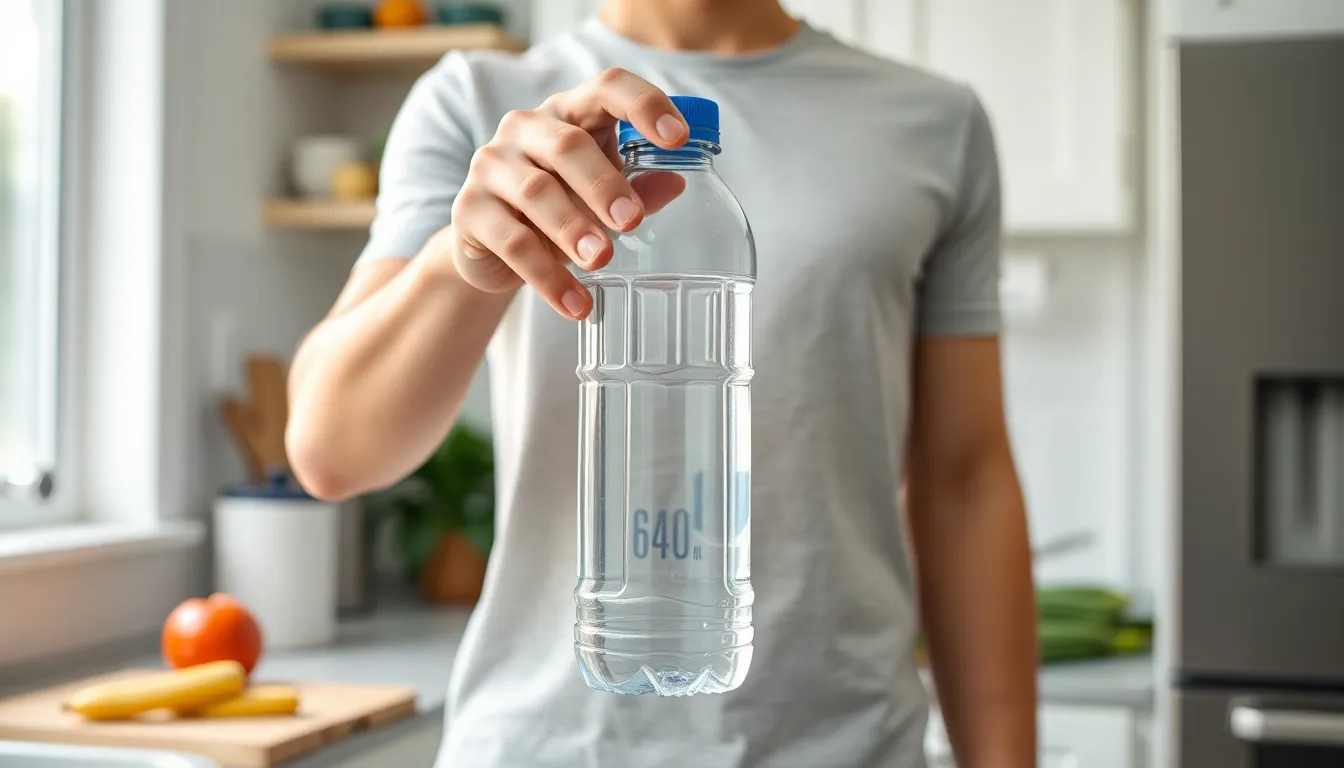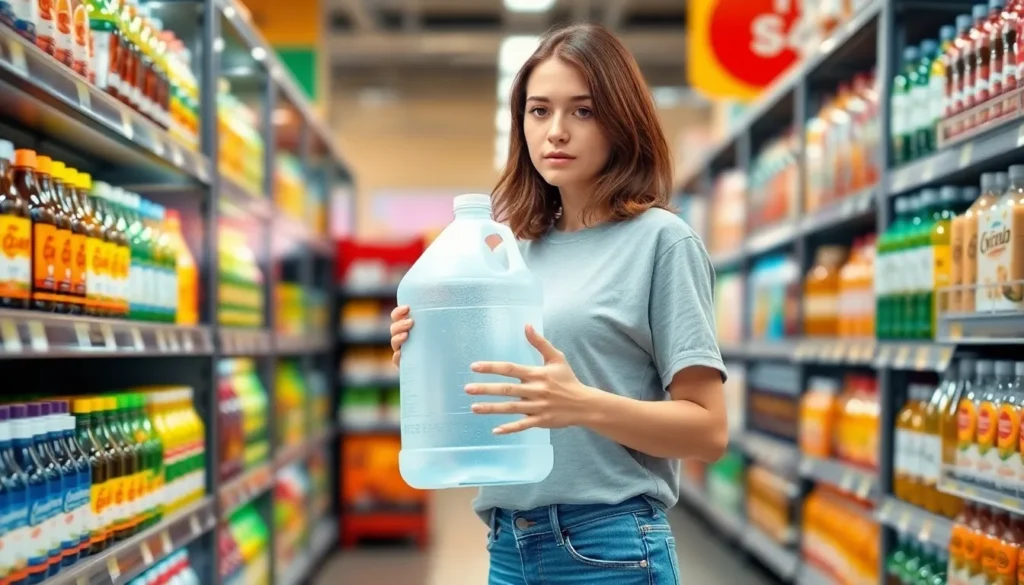When it comes to hydration, the numbers can get a little confusing. Is 64 ounces really a gallon of water, or is it just a clever trick played by the universe? Picture this: you’re at the store, eyeing that massive jug of water, wondering if you’ve just stumbled upon the key to your hydration goals or if you’re about to make a rookie mistake.
Table of Contents
ToggleUnderstanding Gallon Measurements
A gallon comprises 128 ounces. This means that 64 ounces equals half a gallon. Confusion often arises when discussing hydration recommendations. Many people think drinking 64 ounces suffices for daily hydration. However, it’s essential to clarify that this amount only represents half the total volume of a gallon.
In the United States, liquid measurements vary. The fluid ounce is a key unit within these measurements, contributing to the distinction between gallons and smaller volumes. A single gallon contains 128 fluid ounces, while a quart, which is a quarter of a gallon, contains 32 fluid ounces.
Hydration guidelines also recommend varying daily water intake. Many experts suggest aiming for approximately 64 ounces daily but emphasize that individual needs differ based on activity level, climate, and diet.
Individuals need to understand this distinction. Consuming 64 ounces daily may be beneficial for some but not adequate for others. Moreover, tracking water intake can help in assessing whether one achieves the recommended hydration levels.
Awareness of these measurements can help consumers make informed choices. When purchasing water containers, knowing that two 64-ounce jugs will equal one gallon provides clarity. Understanding this can improve hydration efforts while avoiding common misconceptions around gallon measurements.
Converting Ounces to Gallons

Understanding the conversion from ounces to gallons clarifies hydration goals. This knowledge helps avoid confusion about water intake recommendations.
The Ounce to Gallon Ratio
One gallon consists of 128 ounces. Half a gallon measures 64 ounces, commonly perceived as a full gallon. Knowing these numbers simplifies conversion calculations. A quart, another relevant measurement, equals 32 ounces, allowing for additional context when comparing liquid volumes. Tracking fluid intake benefits from converting these measurements into a more understandable format, enhancing hydration awareness.
Practical Examples of Conversion
In everyday scenarios, converting ounces to gallons offers useful insights. For instance, a typical gallon of milk contains 128 ounces, providing a clear visual for half a gallon at 64 ounces. If someone fills a 64-ounce water bottle, that person consumes half a gallon with each refill. Additionally, recipes often require fluid measurements, making it vital to convert ounces for cooking or baking accurately. Recognizing these conversions helps manage water intake and ensures individuals meet their hydration preferences effectively.
Addressing the Question: Is 64 Oz a Gallon of Water?
Understanding liquid measurements is essential for maintaining proper hydration. One gallon equals 128 ounces. Consequently, 64 ounces is only half a gallon, not a gallon.
The confusion surrounding this measurement often arises in discussions about hydration guidelines. While recommendations frequently suggest drinking 64 ounces daily, this amount alone does not fulfill the total gallon measure. Tracking water intake can help clarify hydration needs.
In the U.S., liquid measurements follow a standard system where a quart contains 32 fluid ounces. Thus, individuals may consider two quarts or 64 ounces as part of their daily hydration goals. Recognizing the ratio of ounces to gallons reinforces the idea of how much water needs to be consumed.
Examples of everyday products illustrate this concept further. A gallon of milk or juice showcases the importance of knowing that it equals 128 ounces. Many recipes use similar measurements, reinforcing the concept across various contexts.
To dispel misconceptions, understanding that two 64-ounce jugs make up one gallon becomes clear. This knowledge helps individuals feel confident about their hydration choices. Keep in mind that individual water needs depend on several factors like physical activity and climate. With this information, one can enhance awareness of hydration habits.
Common Misconceptions About Gallon Measurements
Many people mistakenly think that 64 ounces equals a full gallon. This belief often stems from the routine recommendation to drink that amount for hydration. Clarity can enhance understanding; one gallon contains 128 ounces, making 64 ounces only half a gallon.
It’s common to hear about quarts in relation to gallons. Each quart contains 32 fluid ounces, which means two quarts add up to 64 ounces. This further illustrates how individuals can easily misinterpret measurements.
Individuals might also confuse other liquid forms with gallons. For instance, a standard gallon of milk and a gallon of juice visually show the equivalent volume. This confusion often results in incorrect assumptions about how much water one should drink.
Various factors can influence personal hydration needs. Activity levels, climate, and dietary habits all contribute to the required daily water intake. Understanding these factors allows individuals to tailor their fluid consumption appropriately.
Tracking water intake remains crucial for proper hydration. Using common household items, such as a large water bottle marked with ounces, can aid in monitoring fluid consumption. This practice reinforces the importance of knowing actual measurements.
Examples in cooking can also bring clarity. Many recipes include specific liquid measurements, emphasizing the need for an accurate understanding of gallons and ounces. Instruction in this context can fortify comprehension about portion sizes and daily hydration goals.
Misconceptions about gallon measurements can lead to inadequate hydration. Ensuring knowledge about these basic conversions supports better health outcomes. Keeping this information in mind encourages making informed choices about daily water consumption.
Benefits of Drinking Water Daily
Drinking water daily offers numerous health benefits. Hydration plays a vital role in maintaining the body’s temperature, aiding in digestion, and promoting nutrient absorption. Enhanced cognitive function results from adequate hydration, improving focus and clarity throughout the day.
Weight management often becomes easier with sufficient water intake. Drinking water before meals can reduce appetite, potentially leading to lower calorie consumption. Improved skin health also connects to proper hydration, as well-hydrated skin tends to look more radiant and youthful.
Regular water consumption supports kidney function by helping flush out toxins. Healthy kidneys filter waste from the bloodstream efficiently, preventing the risk of kidney stones and urinary tract infections. Drinking water can even alleviate fatigue, as dehydration commonly manifests as tiredness.
Energy levels see a boost with increased water intake. Athletes and physically active individuals benefit from staying hydrated before, during, and after exercise. Endurance can be maximized, leading to enhanced performance and recovery.
Hydration supports joint lubrication, crucial for maintaining mobility and reducing discomfort during physical activities. Additionally, water acts as a natural headache remedy; dehydration often triggers headaches and migraines.
Most health recommendations suggest a daily water intake of about 64 ounces for general well-being. Monitoring hydration by tracking daily water consumption empowers individuals to meet their unique hydration needs effectively. Tracking methods can include using marked water bottles or apps designed specifically for monitoring fluid intake.
Understanding the difference between 64 ounces and a gallon is essential for anyone looking to stay hydrated. With a gallon equaling 128 ounces two 64-ounce servings only make up half a gallon. Recognizing this distinction helps individuals better track their water intake and meet their hydration goals.
Personal hydration needs can vary significantly based on several factors. By monitoring water consumption and being aware of liquid measurements individuals can make informed choices that support their overall health. Staying hydrated is vital for numerous bodily functions and knowing how much water to drink can lead to improved well-being.








